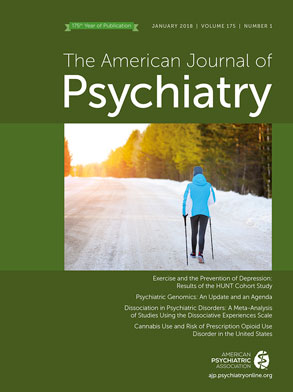There has been considerable speculation in academic journals and in the mass media that access to medical cannabis may reduce the use of prescription opioids for analgesia and pain control. An opioid overdose mortality analysis in states that permitted or did not permit medical cannabis (
1) reported a 25% reduction in mean annual opioid overdose mortality in the medical cannabis states and noted that the association strengthened with more years of medical cannabis. An economic analysis with additional data (
2) found that the association with overdose mortality was strongest in states that controlled access to medical cannabis through dispensaries; the presence of dispensaries, moreover, was associated with reductions in the nonmedical use of opioids and admissions to publicly funded addiction treatment centers for opioid use disorders related to prescription opioids. The effect, moreover, may generalize to other disorders. A review of prescription data from Medicare Part D for the period 2010–2013 (
3) examined prescriptions for disorders where cannabis has been suggested as an alternative medication and noted declines in the use of prescriptions for anxiety, depression, glaucoma, nausea, pain, psychosis, seizures, sleep disorders, and spasticity after the introduction of state laws authorizing medical marijuana, with the largest decline associated with pain medications.
Is the solution to the opioid epidemic as simple as the legalization of medical cannabis? Commenting on the Bachhuber et al. analysis (
1), Finney et al. (
4) cautioned that an ecological fallacy may be present—individuals using medical marijuana could have elevated overdose mortality rates even though there is a state-level reduction. They contended that a prospective study of individual pain patients was necessary to assess relationships between cannabis use, use of opioid medications, and other substance use (
4).
An article in this issue speaks to that need. Olfson et al. (
5) examined data from two waves of the National Epidemiologic Survey on Alcohol and Related Conditions (NESARC) and used logistic regression to assess associations between cannabis use at time 1 (2001–2002) and the nonmedical use of opioids and prescription opioid use disorder at time 2 (2004–2005). Controlling for participant characteristics (age, gender, race/ethnicity, family history, other substance use disorders, and time 1 mood and anxiety disorders and nonmedical opioid use), cannabis use at time 1 was associated with an elevated adjusted odds ratio for nonmedical opioid use (adjusted odds ratio=3.5) and initiation of nonmedical use of opioids (adjusted odds ratio=2.6). The associations persisted when the analysis was restricted to individuals without cannabis use disorders at time 1 and among individuals with moderate to extreme pain interference in the past 2 weeks. Development of an opioid use disorder at time 2 occurred more frequently among individuals who were occasional (2.9%), frequent (4.3%), and very frequent (4.4%) cannabis users at time 1 than nonusers (0.5%). Time 1 cannabis use was also associated with increased levels of nonmedical opioid use at time 2. The authors conclude, “At the individual level, cannabis use appears to substantially increase the risk of nonmedical opioid use.”
The Olfson et al. analysis of course does not resolve the debate about associations between medical cannabis use, use of prescription opioids, and risks of opioid overdose mortality. The study is nonetheless an important contribution that balances the state-level analyses with individual-level data. The outcomes are less counterintuitive than the associations reported in the analyses of state-level data. The study’s strengths are the use of a large data set (more than 35,000 participants) and responses from the same participants at two points in time using well-validated measures. The large sample facilitates identification of small effects. The data, however, are self-report, are more than a decade old, and do not differentiate between medical and nonmedical cannabis use, and some of the associations are based on relatively small samples.
The contrasting associations from the state-level and the person-level analyses should serve as a caution to eager advocates and puzzled policy makers. It is too soon for science to provide definitive guidance. The landscapes of cannabis and opioid use continue to change rapidly as new policies and new products are introduced. The CDC guidelines for prescribing opioids, for example, may have a substantial influence on opioid prescribing patterns (
6). Contemporary marijuana products, moreover, are not the simple “weed” of the 1960s and 1970s. Selective breeding has produced cannabis strains with substantially elevated tetrahydrocannabinol (THC) levels, and entrepreneurs are marketing cannabis concentrates that are ingested and inhaled using a wide variety of devices. The potential harms and benefits of the THC concentrates are unknown.
It is time, therefore, in states where cannabis use is authorized for adults, to build patient registries of cannabis use that link with medical records so that it is feasible to assess morbidity and mortality associated with the frequency, duration, and method of using various forms of cannabis (e.g., buds, hash, oils, resins, dabs, and candies via pipes, bongs, vaporizers, lozenges, and lotions). Patient registries, in the long term, can provide more definitive data on the relative safety of cannabis products and on the potential beneficial and harmful effects of persistent and occasional use. Once embedded in electronic medical records with consistent cannabis-use questions and response categories, large quantities of registry data could be collected with relatively modest investments in data oversight and quality and at far lower cost than for large-scale clinical trials.
Science and policy develop iteratively. The Olfson et al. study is a critical contribution and will stimulate development of new analyses and more complete understandings of the complex relations between cannabis, medical cannabis, and opioid prescribing and use.

